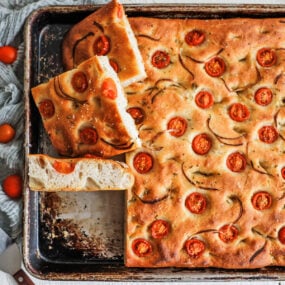

Tomato Focaccia Recipe
This golden Tomato Focaccia, topped with cherry tomatoes, sweet onions, and fresh rosemary, is a simple and irresistible Italian bread.
Ingredients
For the Biga:
- 2 ¼ cups bread flour
- 2/3 cup + 1 teaspoon filtered lukewarm water
- 1/3 teaspoon active dry yeast
For the Dough:
- 2 ¼ cups bread flour
- 1 1/3 cup + 1 teaspoon filtered lukewarm water
- 1 teaspoon active dry yeast
- 2 teaspoons coarse salt + ½ teaspoon
- 6 tablespoons olive oil
- 1 cup cherry tomatoes, sliced in half
- ¼ thinly sliced red onion
- 1 tablespoon finely minced fresh rosemary
Instructions
For the Biga:
- Add the flour, water, and yeast to a large bowl. Using your hands, gently mix and fold everything together to combine. This should take you about 3 to 4 minutes. Throughout the process of making the biga, the dough will start to become shaggy.
- Bring the shaggy dough a bit more together to form a loose ball. Then, transfer it to a plastic container with a lid. You can leave it in the bowl covered with plastic.
- It can sit at a room temperature of 72° or less for 8 to 24 hours. If you are over those temps, I recommend letting it sit at room temperature for 4 to 6 hours, then placing it in the fridge for 24 hours, and up to 72 hours.
For the Dough:
- In a stand mixer with the hook attachment on low speed, add the flour and 1 cup of the lukewarm water and mix to combine, about 2 to 3 minutes. Let it sit for 30 minutes to autolyse.
- Next, add in all of the biga, the remaining 1 teaspoon of active yeast, 2 teaspoons of coarse salt, and 1/3 cup plus 1 teaspoon of lukewarm water, and mix on low speed until combined and the biga is broken up, which takes about 3 to 4 minutes.
- Turn the speed to high and mix it until the dough has cleaned the bowl, which takes about 5 minutes. The dough should have good elasticity. See note about sticky dough.
- Brush a Lloyd pan, half sheet tray, or non-stick 13x9 metal pan with 2 tablespoons of olive oil.
- Transfer the dough to the center of the pan. Cover with a towel and let it proof for 60 to 90 minutes or until it is doubled in size. It should spread across the pan, not rise up during this process.
- Next, using your finger tips, press down into and all across the dough while stretching it to each corner. Cover with a towel and let it proof for 60 to 90 minutes or until it is doubled in size. It should come to the lip of the pan.
- Preheat the oven to 425°F (convection) or 450°F (no convection).
- Drizzle the remaining 4 tablespoons of olive oil all over the dough and again press your fingertips down into and all over the dough, creating dimples.
- Evenly add the tomatoes over the dough into the already created dimples. Evenly sprinkle on the thinly sliced onions and rosemary.
- Bake on the middle rack at 425°F (convection) for 20 minutes. Transfer to a cooling rack and cool to room temperature. Enjoy.
Notes
Making the focaccia by hand? Try not to panic if the dough feels very wet or it’s challenging to handle. A hydrated dough yields fluffy focaccia with an open, airy crumb every time. Instead of adding more flour to the dough, coat your hands and bowl lightly with olive oil to make handling easier. A bench scraper is also your best friend when the dough inevitably sticks to the counter.
Water temperature matters: Both the biga and the focaccia dough are very sensitive to water temperature. If your water is too hot, it will kill the yeast; if it's too cold, fermentation will slow way down. Aim for lukewarm filtered water between 100ºF and 105°F for the most reliable rise.
When it’s done, the focaccia should be deeply golden with slightly crisp edges. If the top is brown but the bottom is pale, leave it in a few extra minutes (better a well-baked crust than underdone bread).
Optional toppings: Try tucking roasted garlic cloves or thinly sliced black or green olives into the dimples alongside the tomatoes and onion. For something heartier, scatter mozzarella, feta, or goat cheese crumbles over the top. You could also mix and match the rosemary with basil, thyme, oregano, or sage.
Steaming technique: Steaming is a popular technique bakers use to bake bread that is soft on the inside and crisp on the outside. If you’d like to try this, place a small pan of hot water in the oven during the first 10 minutes of baking.
Make-Ahead: Bake the focaccia up to 1 day ahead of serving. For the focaccia dough, prepare it up until after the first rise is complete. Then, keep it in a covered bowl in the refrigerator overnight. Bake the next day.
How to Store: Keep the baked bread covered and on the kitchen counter for up to 2 days. It also freezes well for up to 2 months.